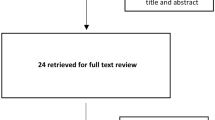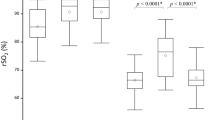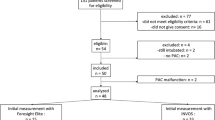Abstract
We evaluated the relationship between regional cerebral oxygen saturation (rSO2) measured by near-infrared spectroscopy (NIRS) cerebral oximeter with superior vena cava (SVC), inferior vena cava (IVC), right atrium (RA), and pulmonary artery (PA) saturation measured on room air and 100% inspired oxygen administered via a non-rebreather mask (NRB) in children. Twenty nine pediatric post-orthotopic heart transplant patients undergoing an annual myocardial biopsy were studied. We found a statistically significant correlation between rSO2 and SVC saturations at room air and 100% inspired oxygen concentration via NRB (r = 0.67, p = 0.0002 on room air; r = 0.44, p = 0.02 on NRB), RA saturation (r = 0.56, p = 0.002; r = 0.56, p = 0.002), and PA saturation (r = 0.67, p < 0.001; r = 0.4, p = 0.03). A significant correlation also existed between rSO2 and measured cardiac index (r = 0.45, p = 0.01) and hemoglobin levels (r = 0.41, p = 0.02). The concordance correlations were fair to moderate. Bias and precision of rSO2 compared to PA saturations on room air were −0.8 and 13.9%, and they were 2.1 and 15.6% on NRB. A stepwise linear regression analysis showed that rSO2 saturations were the best predictor of PA saturations on both room air (p = 0.0001) and NRB (p = 0.012). In children with biventricular anatomy, rSO2 readings do correlate with mixed venous saturation.


Similar content being viewed by others
References
Abdul-Khaliq H, Schubert S, Troitzsch D, et al. (2001) Dynamic changes in cerebral oxygenation related to deep hypothermia and circulatory arrest evaluated by near-infrared spectroscopy. Acta Anaesth Scand 45:696–701
Abdul-Khaliq H, Troitzsch D, Schubert S, et al. (2002) Cerebral oxygen monitoring during neonatal cardiopulmonary bypass and deep hypothermic circulatory arrest. Thorac Cardiovasc Surg 50:77–81
Andropoulos DB, Stayer SA, Diaz LK, Ramamoorthy C (2004) Neurological monitoring for congenital heart surgery. Anesth Analg 99:1365–1375
Bland JM, Altman DG (1999) Measuring agreement in method comparison studies. Stat Methods Med Res 8:135–160
Boushel R, Langberg H, Olesen J, et al. (2000) Regional blood flow during exercise in humans measured by near-infrared spectroscopy and indocyanine green. J Appl Physiol 89:1869–1878
Casati A, Fenelli G, Pietropaoli P, Proeittu R (2004) Paper presented at the American Society of Anesthesiologists annual meeting, Las Vegas, NV
de la Rocha AG, Edmonds JF, Williams WG, Poirier C, Trusler RN (1978) Importance of mixed venous oxygen saturation in the care of critically ill patients. Can J Surg 21:227–229
Edwards AD, Richardson C, Van der Zee P, et al. (1993) Measurement of hemoglobin flow and blood flow by near-infrared spectroscopy. J Appl Physiol 75:1884–1889
Fernandez EG, Green TP, Sweeney M (2004) Low inferior vena caval catheters for hemodynamic and pulmonary function monitoring in pediatric critical care patients. Pediatr Crit Care Med 5:14–18
Fortune PM, Wagstaff M, Petros AJ (2004) Cerebro-splanchnic oxygenation ratio (CSOR) using near infrared spectroscopy may be able to predict splanchnic ischaemia in neonates. Intensive Care Med 27:1401–1407
Hampson NB, Piantadosi CA (1998) Near infrared monitoring of human skeletal muscle oxygenation during forearm ischemia. J Appl Physiol 64:2449–2457
Henson LC, Calalang C, Temp JA, Ward DS (1998) Accuracy of a cerebral oxmieter in healthy volunteers under conditions of isocapnic hypoxia. Anesthesiology 88:58–65
Hoffman GM, Mussatto KA, Brosig CL, et al. (2005) Systemic venous oxygen saturation after the Norwood procedure and childhood neurodevelopmental outcome. J Thorac Cardiovasc Surg 130:1094–1100
Inomata S, Nishikawa T, Taguchi M (1994) Continuous monitoring of mixed venous oxygen saturation for detecting alterations in cardiac output after discontinuation of cardiopulmonary bypass. Br J Anaesth 72:11–16
Jobsis FF (1977) Non-invasive, infra-red monitoring of cerebral O2 sufficiency, blood volume HbO2-Hb shifts and blood flow. Acta Neurol Scand Suppl 64:452–453
Kaiser JR, Gauss CH, Williams DK (2004) Surfactant administration acutely affects cerebral and systemic hemodynamics and gas exchange in very-low-birth-weight infants. J Pediatr 144:809–814
Kasnitz P, Druger GL, Yorra F, Simmons DH (1976) Mixed venous oxygen tension and hyperlactatemia. Survival in severe cardiopulmonary disease. J Am Med Assoc 236:570–574
Kazarian KK, Del Guercio LR (1980) The use of mixed venous blood gas determinations in traumatic shock. Ann Emerg Med 9:179–182
Kim MB, Ward DS, Cartwright CR, et al. (2000) Estimation of jugular venous O2 saturation from cerebral oximetry or arterial O2 saturation during isocapnic hypoxia. J Clin Monit Comput 16:191–199
Krauss XH, Verdouw PD, Hughenholtz PG, Nauta J (1975) Online monitoring of mixed venous oxygen saturation after cardiothoracic surgery. Thorax 30:636–643
Kremzar B, Spéac-Marn A, Kompan L, Cerovic O (1997) Normal values of SvO2 as therapeutic goal in patients with multiple injuries. Intensive Care Med 23:65–70
Krivec B, Vogá G, Podbregar M (2004) Monitoring mixed venous oxygen saturation in patients with obstructive stock after massive pulmonary embolism. Wiener Klin Wochenschrift 116:326–331
Kurth CD, Steven JL, Montenegro LM, et al. (2001) Cerebral oxygen saturation before congenital heart surgery. Ann Thorac Surg 72:187–192
Landis JR, Koch GG (1977) The measurement of observer agreement for categorical data. Biometrics 33:159–174
Lee J, Wright F, Barber R, Stanley L (1972) Central venous oxygen saturation shock: a study in man. Anesthesiology 36:472–478
Mahle WT, Tavani F, Zimmerman RA, et al. (2002) An MRI study of neurological injury before and after congenital heart surgery. Circulation 106:I109–I114
Mancini DM, Bolinger L, Li H, et al. (1994) Validation of near-infrared spectroscopy in humans. J Appl Physiol 77:2740–2747
McCormick PW, Stewart M, Goetting MG, Balakrishnan G (1991) Regional cerebrovascular oxygen saturation measured by optical spectroscopy in humans. Stroke 22:596–602
McCormick PW, Stewart M, Goetting MG, et al. (1991) Noninvasive cerebral optical spectroscopy for monitoring cerebral oxygen delivery and hemodynamics. Crit Care Med 19:89–97
McKinley BA, Marvin RG, Cocanour CS, Moore FA (2000) Tissue hemoglobin O2 saturation during resuscitation of traumatic shock monitored using near infrared spectrometry. J Trauma-Injury Infect Crit Care 48:637–642
Monk T, Weldon J, Van der Aa M (2002) Paper presented at the American Society of Anesthesiologists annual meeting, Orlando, Fl
Nagdyman N, Fleck T, Barth S, et al. (2004) Relation of cerebral tissue oxygenation index to central venous oxygen saturation in children. Intensive Care Med 30:468–471
Nollert G, Jonas RA, Reichart B (2000) Optimizing cerebral oxygenation during cardiac surgery: a review of experimental and clinical investigations with near infrared spectrophotometry. Thorac Cardiovasc Sur 48:247–253
O’Connor TA, Hall RT (1994) Mixed venous oxygenation in critically ill neonates. Crit Care Med 22:343–346
Pollard V, Prough DS, DeMelo AE, et al. (1996) Validation in volunteers of a near-infrared spectroscope for monitoring brain oxygenation in vivo. Anesth Analg 82:269–277
Pollard V, Prough DS, DeMeIo AE, et al. (1996) The influence of carbon dioxide and body position on near infrared spectroscopic assessment of cerebral hemoglobin oxygen saturation. Anesth Analg 82:278–287
Powelson J, Maini BS, Bishop RL, Sottile FD (1992) Continuous monitoring of mixed venous oxygen saturation during aortic operations. Crit Care Med 20:332–336
Prough DS, Pollard V (1995) Cerebral near-infrared spectroscopy: ready for prime time? Crit Care Med 23:1624–1626
Reinhart K, Rudolph T, Bredle DL, Hannemann L, Cain SM (1989) Comparison of central-Venous to mixed-venous oxygen saturation during changes in oxygen supply/demand. Chest 95:1216–1221
Rivers EP, Ander DS, Powell D (2001) Central venous oxygen saturation monitoring in the critically ill patient. Curr Opin Crit Care 7:204–211
Schranz D, Schmitt S, Oelert H, et al. (1989) Continuous monitoring of mixed venous oxygen saturation in infants after cardiac surgery. Intensive Care Med 15:228:232
Sumimoto T, Takayama Y, Iwasaka T, et al. (1991) Mixed venous oxygen saturation as a guide to tissue oxygenation and prognosis in patients with acute myocardial infarction. Am Heart J 122:27–33
Teller J, Wolf M, Keel M, et al. (2000) Can near infrared spectroscopy of the liver monitor tissue oxygenation? Eur J Pediatr 159:549
Thayssen P, Klarholt E (1980) Relation between caval and pulmonary artery oxygen saturation in children. Br Heart J 43:574–578
Thomsen A (1978) Calculation of oxygen saturation of mixed venous blood in infants. Scand J Clin Lab Invest 38:389–392
Tortoriello T, Stayer SA, Mott AR, et al. (2005) A noninvasive estimation of mixed venous oxygen saturation using near-infrared spectroscopy by cerebral oximetry in pediatric cardiac surgery patients. Pediatr Anaesth 15:495–503
Varela JE, Cohn SM, Giannotti GD, et al. (2001) Near-infrared spectroscopy reflects changes in mesenteric and systemic perfusion during abdominal compartment syndrome. Sur 129:363–370
Watzmam HM, Kurth CD, Montenegro LM (2000) Arterial and venous contributions to near-infrared cerebral oximetry. Anesthesiology 93:947–953
Acknowledgment
This work was supported by the University of Arkansas for Medical Sciences College of Medicine Dean’s CUMG/Research Development Fund Grant Program.
Author information
Authors and Affiliations
Corresponding author
Rights and permissions
About this article
Cite this article
Bhutta, A.T., Ford, J.W., Parker, J.G. et al. Noninvasive Cerebral Oximeter as a Surrogate for Mixed Venous Saturation in Children. Pediatr Cardiol 28, 34–41 (2007). https://doi.org/10.1007/s00246-006-1379-z
Received:
Accepted:
Published:
Issue Date:
DOI: https://doi.org/10.1007/s00246-006-1379-z




